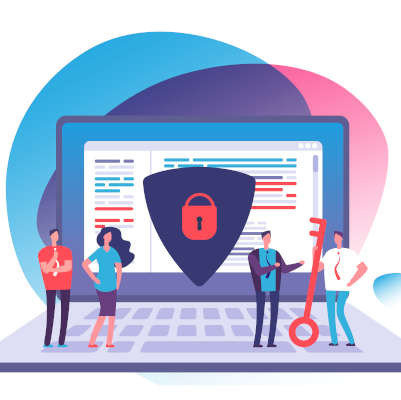We’re sure your business has at least a couple of employees who spend part of their workday in a different location, but are you doing all you can to help them be as productive as possible? While remote work is beneficial in so many circumstances, there are a lot of caveats to it that must be considered. Today, we want to go over how you can mitigate risk and keep remote work from becoming a liability for your company.
Poweron Technology Blog
Remote work has proven incredibly useful over the past few years despite many employers having various concerns about its implementation. While these concerns vary, one prevalent one is how remote operations impact cybersecurity.
If you’re utilizing remote operations to any degree and aren’t concerned about cybersecurity, you must adjust this mindset and correct your approach.
Remote and hybrid work models have become more popular than ever, in no small part thanks to the improved technology businesses of all sizes can now access. Nevertheless, this shift has brought new challenges for organizations everywhere. One such challenge is maintaining and enhancing remote workplace engagement—a crucial aspect that directly impacts employee satisfaction, productivity, and retention.
Remote work has changed the way that businesses approach normal operations. Due in large part to the disruptions of the past couple of years, remote work has become a staple of the business environment, and while you might hear stories of businesses pushing hard to return to the workplace, the reality is that they are the exception rather than the norm.
Do you remember a couple of years back when remote work went from being a privilege to the norm? It’s been a while since then, but many businesses have adopted hybrid or full remote operations, and as such, they are able to retain a semblance of normalcy even without the return of in-office work.
Some businesses have managed to get back to the state they were in prior to the pandemic, but there is a reason why a lot of businesses are not pushing the issue. Let’s go over some of them, and why forcing the issue with your employees is not necessarily a good idea.
Look, we get it: remote work has become a bit of a topic of contention lately. While employees have been relishing the benefits that remote work offers them, many employers have been doing everything they can to bring their workforce back into the workplace.
Now, it wouldn’t be unfair for you to assume that we would push remote work as a managed service provider because we just so happen to assist businesses in managing it as a part of our services. This is true enough…but we aren’t the only ones with an opinion on the topic.
Now, you may or may not have already made the transition back to the office, and this really applies more to those who haven’t yet. However, even those who have may find some utility here—specifically, in determining if a push to a full return to office was the right move.
Let’s explore how today’s employees may react to the news that remote work will no longer be an option.
With many people continuing to work remotely to some extent, it would be irresponsible not to acknowledge that remote work can introduce a level of risk to an organization’s cybersecurity. This makes it all the more important that this security is locked down. Let’s discuss the concept behind zero-trust security, and why it is becoming the benchmark that organizations of all sizes should meet.
While remote work has been a relatively new option for many businesses currently using it in their operations, it has already shown considerable benefits. Having said that, it would be incongruous of us if we didn’t also acknowledge one glaring issue that remote work has helped to foster: a sense of disconnect in many of those making use of it.
With so many companies having successfully made use of remote work for so long, there has been some worry that this extended means of operation will have a detrimental impact on company culture. Let’s discuss why this is something to avoid, as well as how to avoid this withering of your team’s collective working relationship.
Remote work has been embraced over the past two years, in no small part due to the impact of the pandemic. However, some of the impacts of remote work have made it clear to many businesses that its advantages shouldn’t be sacrificed once it is no longer necessary. Let’s review how businesses can improve by continuing the practices of remote work, even after the need for remote work has passed.
It is undeniable that businesses have increasingly been relying on technology. The past year has been especially digital as millions of people were working remotely. Many of these people required some type of technology support. Today, we are going to discuss how companies like ours were able to provide comprehensive IT support to so many people while they worked from home.
Remote work is often lauded for its various benefits—and don’t get us wrong, there are certainly plenty of them to account for. However, it must also be said that remote work is far from perfect. Take the environmental impacts it can have, for instance. Let’s discuss how working from home can prove better for the environment, while also addressing the serious problems it has contributed to—and, just maybe, how we can help minimize some of them.
It is only too common for people to have very different personalities in the office as they do during their off hours, with different standards and practices to suit them. While there is absolutely nothing wrong with that on the surface, you need to be sure that they are at least upholding the kind of security best practices that you expect of them in the office while they are at home.
With remote work becoming the norm for many businesses in their efforts to maintain operations in recent months, this potentially company-saving adoption has not been without its drawbacks. Most notably, the mental health of many employees has been impacted as teams have been working together while keeping apart, in large part because the quick conversations that happen throughout the workday have largely been eliminated.
Many workplaces have started the processes necessary to safely return their employees to typical operations. However, this is going to involve no small amount of preparation in terms of your business’ technology and proactive planning. Let’s consider the different approaches that you could take as you resume operations in a way that helps protect your team while still enabling work to be done.
Since the onset of the coronavirus, many businesses have managed to sustain themselves through remote work—also commonly known as telework. While this strategy has allowed quite a few businesses to survive, it has also opened them up to security threats. Here, let’s focus on one such threat: vishing, or voice phishing.




















